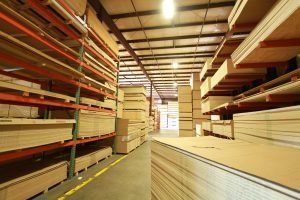Base material classification
Natural plywood
Solid wood plywood
Advantages: strong and durable, natural texture, natural wood aroma.
Disadvantages: high cost, high construction technology, easy to deform.
Application: solid wood flooring, solid wood furniture.
Environmental grade:★★★★★
Process: Made of complete wood (logs), concave and convex shapes are made on the surface of solid wood, and the exterior is painted.
Sizes: 1220mm × 2440mm, 2mm~30mm
Optional: Straight edges, no burrs and cracks, smooth surface coating, no bubbling, no wrinkles.
Wood-based panel
Plywood
Advantages: small deformation, large format, convenient construction, no warping.
Disadvantages: The cost of plywood is high and the glue content is large.
Uses: Furniture, ceilings, wall skirts, floor linings, etc.
Environmental protection level:★★
Process: veneer or thin wood glue to synthesize three or more layers of boards.
Boards made from plywood: blockboard, large core board, glulam / finger joint plywood.
Sizes: 1220mm × 2440mm, 3mm~18mm
Purchase: The wood grain is clear, the front should be flat without stagnation and no defects.
Fiberboard
Advantages: smooth surface, fine material, stable performance, firm edge.
Disadvantages: The moisture resistance is poor, and the nail holding force is worse than that of particleboard.
Uses: laminate flooring, door panels, partition walls, furniture, etc. Environmental level:★★★
Process: It is made of wood fiber or other plant fibers, and applied with urea-formaldehyde resin or other suitable adhesives.
Sizes: 1220mm × 2440mm, 2.4mm~-30mm
Purchase: The surface is free of particles, the surface is smooth and flat, and the whole is elastic.
Functional plywood sheet
Fireproof plywood
Advantages: bright colors, various forms of edge sealing, wear resistance and high temperature resistance.
Disadvantages: The door panel is flat, which cannot create three-dimensional effects, such as bumps and metal.
Uses: furniture, cabinets, showcases, laboratory countertops, exterior walls.
Environmental level:★★★
Process: It is composed of three layers of surface paper, colored paper, and base paper (multi-layer vellum paper), and its base material is particleboard or medium fiberboard.
Sizes: 1220mm × 2440mm, 5~10mm
Purchase: Don’t just buy fireproof veneers, should buy fireproof boards made of veneers and board pressing.
Flame retardant plywood
Advantages: prevent the spread of fire, easy to process, good structural strength.
Disadvantages : There are toxic gases, which have an impact on the bonding strength.
Uses: guesthouses, hotels, conference centers, convention centers. Environmental level:★★★
Process: The plywood is made by rotary cutting the log into small wooden squares, fire-retardant treatment of the wood chips, and then gluing with adhesive.
Sizes: 1220mm × 2440mm, 9~18mm Purchase: The appearance of the color is uniform, the surface is smooth, and the phenomenon of peeling is smooth.
Moisture proof plywood
Advantages: moisture-proof, waterproof, safe and environmentally friendly, anti-deformation.
Disadvantages: There are many fake and shoddy products, and the edge of the plate is easy to be cut.
Application: door panel, wardrobe door
Environmental protection level: ★★
Process: Add granular moisture-proof particles to particleboard, so that the degree of expansion of the board in water is greatly reduced. Sizes: 1220mm × 2440mm, 8-25mm
Purchase: Soak in water to see the moisture-proof performance.
Sound-absorbing plywood
Advantages: sound absorption, environmental protection, flame retardant, heat insulation, heat preservation, moisture proof, mildew proof, easy dust removal.
Disadvantages: The advantages of strong environmental protection and light quality also determine its price is slightly expensive.
Uses: It can be used in places with excessive noise such as grand theaters, concert halls, and theaters.
Environmental level:★★★
Process: Absorb sound waves and reflected waves generated in space through the properties of the material itself.
Sizes: generally 600×600mm, 625 × 625mm, 600 × 1200mm, etc. The thickness is generally 12-22mm.
Purchase: see whether the material of the sound-absorbing plywood is qualified; test its sound-absorbing performance; maintain the sound insulation effect.
Environmental protection grade standard of plywood sheet
E0 grade: formaldehyde emission ≤05mg/L
E1 level: formaldehyde release 05mg-1.5mg/L
E2 level: formaldehyde emission is greater than 1.5mg/L
E0 is the highest environmental protection level; E1 standard can be used for indoor plywood, and most of the plywoods on the market are E1; E2 grade plywood has a strong pungent smell and is not suitable for decoration and living.

